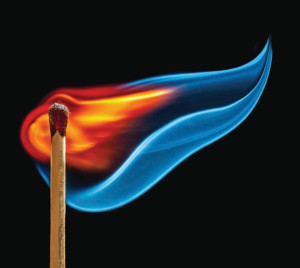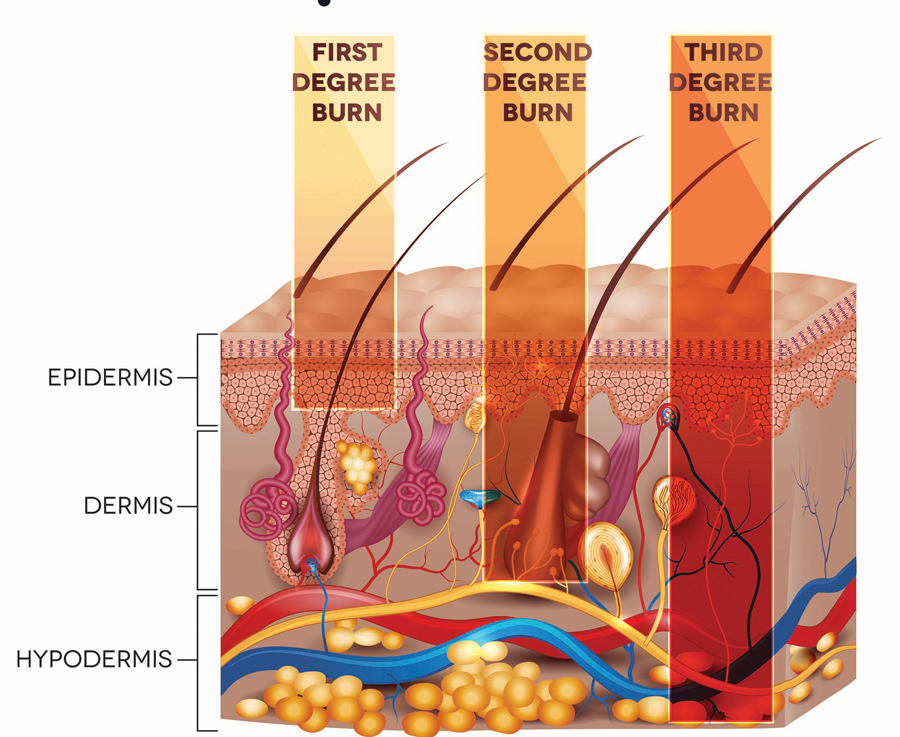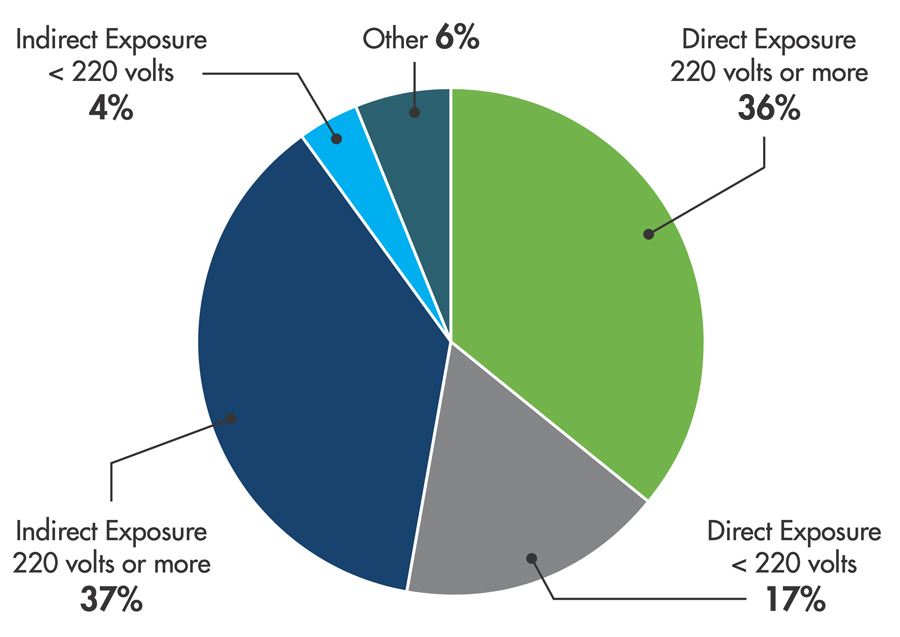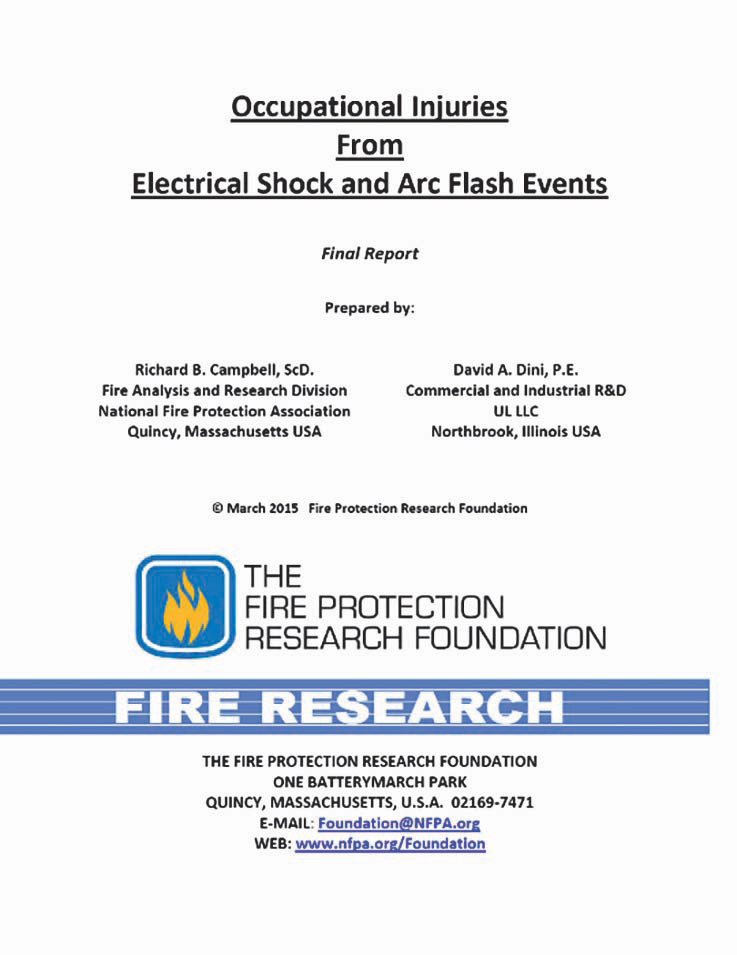How much heat does it take to burn unprotected skin?

Not very much, right? We’ve all had it happen to us: Just stay outside in the sun for a short amount of time with unprotected skin, and there you have it — a burn to your skin.
Now, place unprotected skin in front of a potential source of great heat, such as electrical equipment, and the damage and risk become exponentially greater, and quite possibly lethal.
NFPA 70E addresses the hazards associated with exposure to the four potential burn injuries in the workplace: electrical (shock), thermal (arc flash), chemical (e.g., batteries), and radiation (e.g., X-rays). While all four are dangerous, this article will focus on electrical and thermal burns.
HUMAN SKIN IS VERY FRAGILE
Did you know that burning of the skin can occur at only 118°F? The National Institute for Standards and Technology (NIST) says human skin begins to feel pain at a temperature of 111°F (think hot bathwater). At 118°F, human skin can sustain first-degree burns; a second-degree burn injury can occur at a temperature of only 131°F. While burn severity is a function of exposure time and temperature, human skin is very fragile when elevated temperatures are encountered.
Your skin has three layers.
Epidermis
The epidermis is the outermost (and thinnest) layer of your skin. It protects your body from harm, keeps your body hydrated, produces new skin cells, and contains melanin, which determines the color of your skin.
Dermis
The dermis is the middle layer of the skin. The dermis contains blood vessels, hair follicles, sweat glands, and nerves.
Hypodermis
The hypodermis is the bottom layer of skin in your body. It has many important functions such as storing energy, connecting the dermis layer of your skin to your muscles and bones, insulating your body, and protecting your body from harm.
BURN DEGREE RATINGS
Burns are classified by a degree rating depending on how deeply and severely they penetrate the skin’s surface: first, second, third, and fourth. It should be noted that the initial burn may not be able to be classified, as it can progress and worsen over time, especially in the case of an electrical contact injury or burn (Figure 1).

First-degree (superficial) burns affect only the outer layer of skin, which is the epidermis. For this type of burn, you can expect redness around the affected area and some level of pain. It is dry and has no blisters. An example would be a mild sunburn, and long-term tissue damage is rare.
NFPA 70E primarily focuses on preventing the next classification of burn, the second-degree (partial thickness) burn. Second-degree burns involve the epidermis and part of the lower layer of skin, the dermis. The burn site looks red and blistered and may be swollen and painful. PPE ratings typically protect to a point where a second-degree burn starts. The usual minimum thermal value exposure is 1.2 cal/cm2.
Next, third-degree or full-thickness burns destroy the epidermis and dermis. This burn can go into the innermost layer of skin, the subcutaneous tissue. The burn site may look white or blackened and charred.
Finally, the worst classification is the fourth-degree burn. These burns go through both layers of the skin and underlying tissue as well as deeper tissue, possibly involving muscle and bone. There is no feeling in the area because the nerve endings are destroyed. This classification does not get talked about as much, but it is a level of burn that has devastating consequences for the body.
OK, WE GET IT. BURNS ARE BAD — NOW WHAT?
As qualified electrical workers, we are constantly exposed to the hazards of electricity, and one of the biggest hazards is receiving injury from electrical and thermal burns. How do we prevent injury from occurring? The key is in the first sentence of this definition from NFPA 70E, which defines a qualified person as:
“One who has demonstrated skills and knowledge related to the construction and operation of electrical equipment and installations and has received safety training to identify the hazards and reduce the associated risk.”
Now, read that again. Think about the words and what they mean. It’s the key to everything when it comes to protecting you and those around you. If you understand what you are working on and the potential hazards you will encounter, understand these facts, and take steps to avoid the hazards (including turning it off!), then you have greatly improved your situation and likely will not be hurt or injured. Again, read the words before doing the work!

EFFECTS OF ELECTRICAL CONTACT AND BURNS
A severe electrical burn can be a seriously devastating injury —not only physically, but emotionally as well. The incident will affect not only the burn victim but also the entire family.
NFPA’s Fire Protection Research Foundation produced a report in March 2015 titled Fatal Electrical Injuries at Work. The following information is from the report:
Electrical hazards take a variety of forms and produce different types of injury. The National Safety Council reported in its 2014 edition of Injury Facts that there were 961 fatal injuries from 2008 through 2010 due to exposure to electric current, radiation, temperature, and pressure. While relatively uncommon, electrical injuries are noted for having the potential to be particularly debilitating, with high morbidity and mortality.
Further, the report goes on to say:
The OSHA incidents and research show that a variety of factors contribute to the failure to comply with NFPA 70E requirements — inadequate training, sense of time pressure, desire to meet customer needs, and desire to get scheduled work done. In some cases, injuries result when workers encounter unmarked power sources or unsafe or unanticipated electrical conditions that are left behind by prior work.
The research indicates that many workers who experience electrical injury have inadequate safety training to recognize safety hazards and follow proper procedures. This may frequently be the case in some service occupations, as well as with immigrant workers or workers in temporary positions, but it is also evident that managers and supervisors — even those who work in the electrical field — may not themselves be knowledgeable about electrical hazards, even as they direct the activities of employees who may be exposed to energy sources in the course of their work.
The text in red shows you exactly what the 70E Technical Committee and the electrical safety community strive for each and every day: Produce a work practices standard that identifies the risk, puts forth a mitigation strategy for the risks, and provides guidance to the worker in the field on what type and rating of PPE is necessary to prevent injury.
BURN EXPOSURE
Fatal Electrical Injuries at Work, a 2018 report from the NFPA Research Foundation, states:
Over the five-year period from 2012 – 2016, data from the U.S. Bureau of Labor Statistics (BLS) indicate that 739 workers suffered fatal injuries as a result of exposure to electricity.
Electrical hazards are a potential source of injury to workers in a wide array of work settings. Occupations that routinely involve electrical work are the most obvious at-risk populations for electrical injury, but virtually any environment that utilizes electrical equipment — which is to say, most work settings — may involve exposure to hazardous electrical energy, whether due to frayed cords, faulty equipment, missing ground prongs, or some other factor. It is accordingly important for workers across industry and occupational groups to be able to recognize electrical hazards in their work environments and for employers to take appropriate steps to protect employees from electrical injury.
Exposure Types
Figure 2 from the report shows that “53% of fatal electrical injuries by type of exposure resulted from direct exposure to electricity and 41% from indirect exposure. Exposure was unspecified for 6% of the injuries. Indirect exposure to 220 volts or more accounted for 37% of the fatal injuries and direct exposure to 220 volts or more was responsible for 36% of the injuries. Direct exposure to less than 220 volts accounted for 17% of deaths and indirect exposure to 4% of the deaths.”

Electrical arcing can produce temperatures as high as 35,000°F at the arc terminals and may cause severe burns, hearing loss, eye injuries, skin damage from blasts of molten metal, lung damage, and blast injuries. The threat from electrical thermal burns is real, and many sections of the 70E address protection from arc flash and thermal burns.
Electrical shock, whether low-voltage or high-voltage, creates a unique set of circumstances for medical personnel after a contact event. It should be noted that in high-voltage shocks, direct contact is not required. The resulting arc can carry electrical current from the source to the victim. This is why we focus so much on understanding minimum clearances and approach boundaries. Electricity will literally reach out and grab you.
Current Path
During a shock event, the path at which the current travels and the resulting burns and tissue destruction can place organs at risk and stop your heart. Get a shock to your brain, and you can suffer respiratory arrest, seizures, and paralysis.
An electrical shock incident that involves a vertical path can put your central nervous system, heart, and respiratory system at risk.
A horizontal path, entering one hand and exiting out the other or another part of the body, can pass lethal current across your heart.
Worst of all, should you maintain contact for an extended period of time, serious damage to the body can occur and your clothing may catch on fire.
Persons with severe burns may be left with a loss of certain physical abilities, including loss of limb(s), disfigurement, loss of mobility, scarring, and recurrent infections because the burned skin has decreased ability to fight infection. In addition, severe burns can penetrate deep skin layers, causing muscle or tissue damage that may affect every system of the body.
Burns can also cause emotional problems such as depression, nightmares, or flashbacks from the traumatizing event. The loss of a friend or family member and possessions in the fire may add grief to the emotional impact of a burn.
CONCLUSION
The key to all of this? Educate yourself on the hazards and the risks associated with electrical work, follow safety protocols and OSHA requirements, read and understand NFPA 70E (and importantly the “why” behind the standard), and never, ever, get complacent. Pay particular attention to Article 120 and Article 130. Understand those two sections completely, because if you do so, you can likely prevent an incident from ever happening.
Electricity is not forgiving, but if you follow a few basic safety tenets you won’t have any issues.
And by the way, before working on it? — Turn it off!
ADDITIONAL RESOURCES
Download the complete NFPA report, Occupational Injuries from Electrical Shock and Arc Flash Events, from the Fire Protection Research Foundation, here:
https://www.nfpa.org/News-and-Research/Data-research-and-tools/Electrical/Occupational-Injuries-from-Electrical-Shock-and-Arc-Flash-Events.

REFERENCES
R. Campbell. Fatal Electrical Injuries at Work, NFPA Research Foundation, May 2018. Accessed at https://www.nfpa.org/News-and-Research/Data-research-and-tools/Electrical/Fatal-electrical-injuries-at-work.

Ron Widup is the Vice Chairman, Board of Directors, and Senior Advisor, Technical Services for Shermco Industries and has been with Shermco since 1983. He is a member of the NETA Board of Directors and Standards Review Council; a Principal member of the Technical Committee on Standard for Electrical Safety in the Workplace (NFPA 70E); Principal member of the National Electrical Code (NFPA 70) Code Panel 11; Principal member and Chairman of the Technical Committee on Standard for Competency of Third-Party Evaluation Bodies (NFPA 790); Principal member and Chairman of the Technical Committee on Recommended Practice and Procedures for Unlabeled Electrical Equipment Evaluation (NFPA 791); a member of the Technical Committee Recommended Practice for Electrical Equipment Maintenance (NFPA 70B); and Vice Chair for IEEE Std. 3007.3, Recommended Practice for Electrical Safety in Industrial and Commercial Power Systems. He is a member of the Texas State Technical College System (TSTC) Board of Regents, a NETA Certified Level 4 Senior Test Technician, State of Texas Journeyman Electrician, a member of the IEEE Standards Association, an Inspector Member of the International Association of Electrical Inspectors, and an NFPA Certified Electrical Safety Compliance Professional (CESCP).
